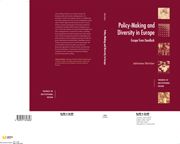Book contents
- Frontmatter
- Contents
- Acknowledgements
- 1 Escaping deadlock: policy-making in Europe
- 2 The context of subterfuge: diversity, fragmentation and the malleability of the European polity
- 3 The analytical approach and theoretical background
- 4 Market-making policy: transport and telecommunications
- 5 The provision of collective goods and the reduction of externalities: environmental policy
- 6 Market-correcting, redistributive policy: regional and social policy
- 7 Market-correcting, distributive policy: research and technology
- 8 Summary and conclusion: stalemate and subterfuge across policy areas
- References
- Index
2 - The context of subterfuge: diversity, fragmentation and the malleability of the European polity
Published online by Cambridge University Press: 22 September 2009
- Frontmatter
- Contents
- Acknowledgements
- 1 Escaping deadlock: policy-making in Europe
- 2 The context of subterfuge: diversity, fragmentation and the malleability of the European polity
- 3 The analytical approach and theoretical background
- 4 Market-making policy: transport and telecommunications
- 5 The provision of collective goods and the reduction of externalities: environmental policy
- 6 Market-correcting, redistributive policy: regional and social policy
- 7 Market-correcting, distributive policy: research and technology
- 8 Summary and conclusion: stalemate and subterfuge across policy areas
- References
- Index
Summary
The simultaneity of deadlock and development
It has been claimed that the parallel presence of gridlock and growth evolves from two central properties of the European polity – its diversity and its consensual decision-making practices. The variance in the goals pursued by actors has generated an institutionally fragmented polity which demands consensual and interlocking decision-making practices developed to conciliate conflicting goals rather than to provide strong executive leadership. Yet, paradoxically, the very fragmentation and complexity of the decisional structure created to accommodate diversity, and which, in the straightforward decision-making process in the central arena (Council), tends to lead to a stalemate or ‘joint decision trap’ (Scharpf 1988), simultaneously offers ample room for escape routes to overcome potential deadlocks and to speed up policy developments. The very complexity and opaqueness of the institutional structure offer multiple opportunities for creative actors, not only in the Commission and the European Parliament, but also in the member states, to take policy initiatives and to see them through by side-stepping existing obstacles in the decisional process. This leads not only to a strong element of policy entrepreneurship, and the chance for first-movers to wield influence in the process of policy definition, but also to a good deal of policy improvisation and policy unpredictability (Mazey and Richardson 1992).
- Type
- Chapter
- Information
- Policy-Making and Diversity in EuropeEscape from Deadlock, pp. 6 - 12Publisher: Cambridge University PressPrint publication year: 1999



